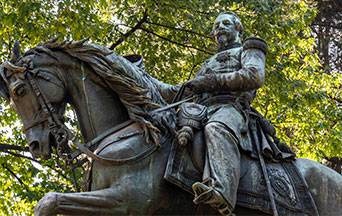
Louis Veuillot succeeded in forming a grand Catholic movement under the banner of his newspaper l’Univers. He did this in three ways: the clear exposition of Catholic doctrine, taking principles to their ultimate consequences, and rejecting liberal maxims and methods.
Liberals did the contrary. They were full of optimism, feared irritating enemies of the Church, and were, therefore, unwilling to fight them.
Ironically, the newspaper’s closure and Napoleon III’s Italian policy produced what the Emperor feared the most. The Ultramontanes, who once saw Napoleon as the protector of the Papal States threatened by Italian revolutionaries, were disappointed and moved resolutely to the opposition.
Eternal and Natural Law: The Foundation of Morals and Law
Liberal Catholics had been hostile to the Second Empire since its proclamation in 1852. The liberal opposition grouped together all the regime’s political opponents. The latter welcomed the Monarchist Count de Falloux with open arms when Napoleon had carried out his coup d’état. With his help, Louis Napoleon’s former minister Falloux and Bishop Dupanloup slowly but surely created so-called liberal Catholicism.
The heads of the liberal opposition supported the Holy See on the Italian question, seeing it only as a pretext to separate Catholics from the Empire completely. Fr. Henri-Dominique Lacordaire’s election to the French Academy, a center of resistance to the government entirely dominated by liberal politicians, was characteristic of this attitude. Many renowned liberal Catholics, followers of Bishop Dupanloup, the Duke de Broglie, etc., were members. The Count of Montalembert ardently desired Lacordaire’s election, but the candidacy met with resistance precisely because of Lacordaire’s hesitant defense of the Holy See. Nevertheless, he was elected, a fact regarded as an Academy protest against the Emperor’s policy.
Few Catholics supported Napoleon III to the end. Bishop Maret, always on the side of the Holy See’s opponents, was one of them. However, they were isolated cases that had no repercussions on public opinion. Thus, Catholics, in general, rose unanimously to protest Louis Napoleon’s aberrations. That forced the Emperor to back down and delayed Italian unification until 1870.
On January 20, 1860 (ironically, the day after the publication of the Encyclical Nullius certe, which caused the closure of l’Univers), King Victor Emmanuel of Sardinia-Piedmont recalled Camillo, Count of Cavour to the cabinet. The King gave Cavour the portfolios of the Interior and Foreign Affairs. In this position, the Count was better able to lead revolutionary agitation. The moment was propitious because of Napoleon III’s connivance and England’s unexpected help. The English Prime Minister, Lord John Russel, supported the Piedmont policy because he wanted to combat French influence in Italy.
 Learn All About the Prophecies of Our Lady of Good Success About Our Times
Learn All About the Prophecies of Our Lady of Good Success About Our Times
Immediately after retaking the reins of government, Cavour boldly reaffirmed the people’s supposed right to decide their fate freely. He resumed his old methods to influence that “free decision.” The Count gave his secret agents, mere disturbers of order, this instruction: “Take a threatening tone. I need to be able to say that I was outdone.”
On March 22, 1860, Modena, Parma, Tuscany, and the Legations were incorporated into Piedmont. In late April, Savoy and Nice, “freely deciding their fate,” became French by an almost unanimous plebiscite. It was the price Napoleon III accepted for the aid he gave the revolution. But the Emperor had gone too far. Even the French coldly received the annexation of Savoy and Nice.
Pius IX tried to organize the resistance by appointing Monsignor Xavier de Mérode to the Defense Ministry. They formed a volunteer army that became the Papal Zouaves. An opponent of Napoleon III, the French General Christophe Léon Louis Juchault de Lamoricière, led it successfully. Its members were volunteers from all nations. Unfortunately, those improvised forces were unable to effectively oppose Piedmont’s fierce troops.
Garibaldi invaded Italy from the south. The Piedmontese advanced from the north. General Lamoricière was defeated at Castelfidardo, and the entire Peninsula, except for Rome, fell into the hands of the revolutionaries.
Cavour ordered the occupation of the City of Viterbo as well. This angered the French Emperor. Seeing internal opposition to his government increase daily, Napoleon III ordered General Gourjon to retake it. Irritated, Cavour asked France which territory it deemed inviolable. The answer came on October 2: Civittà Vecchia and Viterbo to the north, Velletri to the south, and the outskirts of Rome to the east as far as Civittà-Castellana. The capture of Rome was thus postponed and only came to pass ten years later, in 1870.
10 Razones Por las Cuales el “Matrimonio” Homosexual es Dañino y tiene que Ser Desaprobado
Although weakened by this rivalry, Napoleon III never backtracked on the Italian question. Nonetheless, the backlash was very strong, and the encyclical Nullius certe unleashed a wave of demonstrations supporting the Holy Father. Italy’s unification could not happen without adequate psychological preparation, which required time. After 1860, the Second Empire could no longer count on the Ultramontanes, who constituted a considerable portion of public opinion.
Gradually, the Emperor moved toward a more liberal Empire, which greatly encouraged liberal Catholics. Deprived of l’Univers, Louis Veuillot devoted seven years to publishing books on burning issues.
Photo Credit: © S J Lievano – stock.adobe.com

